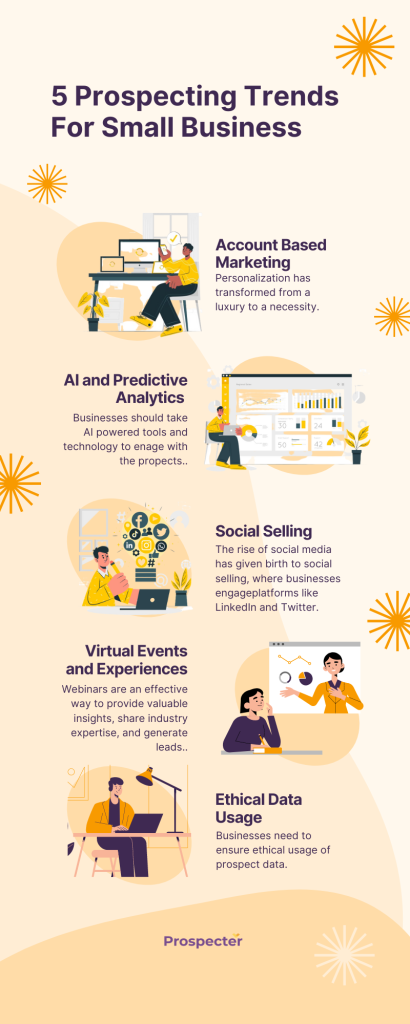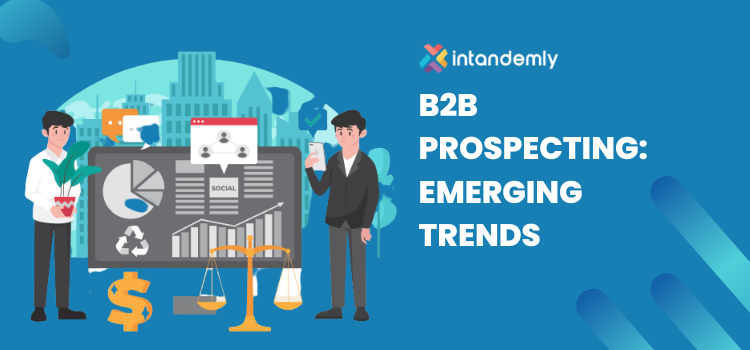B2B Prospecting: Emerging Trends
INTRODUCTION:
As technology continues to advance at a pace, so too do the strategies and techniques used in the modern B2B world. In today's evolving landscape, it is crucial for companies to stay ahead of emerging trends in order to effectively reach their target audience and drive growth.As technology continues to shape the way companies connect with potential clients, a shift towards more personalized and human-centric approaches is becoming increasingly important.Gone are the days of generic cold calling and mass email blasts; today's B2B prospecting requires companies to deeply understand their target audience and tailor their outreach accordingly.B2B prospecting has transformed into a dynamic field filled with exciting opportunities. This blog aims to explore the emerging trends in B2B prospecting, emphasizing the importance of staying updated with the latest practices in order to remain competitive in the market.
Top Emerging Prospecting Trends
Account-Based Marketing (ABM):Personalization OutreachPersonalization has transformed from a luxury to a necessity. One of the key trends in B2B prospecting is the emphasis on personalization in outreach efforts. Gone are the days of generic sales pitches .Today, successful prospecting involves tailoring communication to address the specific needs and pain points of each prospect. By demonstrating a genuine understanding of their business and offering customized solutions, companies can significantly improve their conversion rates.
With advanced CRM tools and automation, businesses can now deliver tailored messages at scale. According to research by Evergage, 88% of marketers report measurable improvements due to personalization, leading to higher engagement and conversions.For instance, Amazon Business offers personalized product recommendations to its B2B customers based on their browsing history and preferences.
There are various ABM Softwares available particularly for small and medium business on budget with unique features.You can check them out.
Example: A software company could reach out to a potential client by highlighting how their product addresses the specific challenges faced by businesses in that industry, resulting in higher engagement and better chances of success.
AI and Predictive Analytics: Data Driven
Another trend gaining momentum is the use of technology and automation in B2B prospecting.With the rise of artificial intelligence (AI) and machine learning, businesses are leveraging advanced tools to automate repetitive tasks, streamline processes, and gain valuable insights. Moreover AI can also analyze vast datasets to identify potential leads that align with ideal customer profile.
According to a recent study, organizations that effectively utilize data and analytics in their prospecting efforts experience a 35% increase in their win rates.
AI-powered chatbots, for instance, are being used to engage with prospects in real-time and provide instant support, making the lead qualification process more efficient. Additionally, predictive analytics enables companies to identify promising leads based on historical data, allowing for more targeted outreach and higher conversion rates.However, it's crucial to strike the right balance between automation and personalization to ensure that your prospects feel valued and not just another number on your list.
Social Selling: Building Relationships Online
Social media platforms have also emerged as a game-changer in B2B prospecting. The rise of social media has given birth to social selling, where businesses engage and build relationships with prospects on platforms like LinkedIn and Twitter.As professionals increasingly utilize platforms like LinkedIn to establish their personal brand and connect with industry peers, businesses have realized the potential of leveraging these networks for lead generation.
By engaging with relevant content, participating in industry discussions, and building thought leadership, companies can position themselves as trusted authorities within their target market. This, in turn, attracts prospects who are more likely to engage in meaningful conversations and explore potential partnerships.
An IDC study suggests that 75% of B2B buyers and 84% of senior executives use social media to support purchase decisions. IBM's social selling program helped its sales team generate 400% more sales opportunities and 4 times more revenue.
Example: A marketing agency could share a blog post on LinkedIn discussing the latest trends in digital marketing, attracting the attention of potential clients who are interested in staying updated in their industry.

Virtual Events and Experiences: Digitally Engaging Prospects
Amist pamdemic the rise of remote work has further necessitated a shift in B2B prospecting strategies. With fewer face-to-face interactions, businesses are adapting by utilizing virtual events, interactive workshops,webinars, and online communities to reach and engage their target audience. Webinars, in particular, have gained traction as an effective way to provide valuable insights, share industry expertise, and generate leads.
According to Bizzabo, 93% of event marketers plan to invest in virtual events moving forward.
By leveraging web conferencing platforms, companies can host interactive sessions that foster engagement and create a sense of community, positioning themselves as valuable resources within their industry.Consider a marketing automation software company hosting a virtual summit to showcase their product's capabilities and thought leadership.
Ethical Data Usage: Privacy and Trust
With increased emphasis on data privacy and protection, businesses need to ensure ethical usage of prospect data. Compliance with regulations like GDPR builds trust with prospects.This trend revolves around respecting privacy and building trust with potential clients, a crucial factor in establishing long-lasting relationships.
By obtaining consent before collecting and using data, businesses show their commitment to transparency and customer-centricity. According to a study by Cisco, 80% of consumers are more likely to do business with a company if it clearly states how it uses personal data.
For instance, consider a local marketing agency that collects data through their website's contact form. Instead of bombarding prospects with unsolicited emails, they prioritize obtaining explicit consent and tailor their communication to individual preferences. This approach not only avoids potential legal issues but also showcases their dedication to respecting prospect privacy.
However, data and data breaches coexist. Small businesses must assure prospects that their information is safe. Implementing security measures and communicating these measures to prospects builds confidence. A survey by Deloitte indicates that 79% of consumers are more likely to engage with brands that value data protection.
CONCLUSION:
B2B prospecting is a dynamic landscape where adaptability is key. So whether you're a seasoned B2B marketer or just starting out in the industry, this blog will provide you with valuable insights and practical tips to elevate your prospecting game.
By embracing personalized approaches, leveraging technology, tapping into social media networks, exploring virtual engagement opportunities and ethical data usage,businesses can stay ahead of the curve and build fruitful relationships with their prospects.
Incorporating these evolving trends into your B2B prospecting strategies will not only enhance your chances of success but also establish your brand as a trusted and reliable partner in the industry. Stay informed, be proactive, and consistently refine your approach to ensure long-term growth in today's dynamic business environment.
As B2B prospecting continues to evolve, those who are quick to adopt these trends will undoubtedly lead the pack, building stronger connections with prospects and reaping the rewards of sustainable growth.
Remember, successful prospecting is not just about reaching out to potential clients; it's about building relationships and providing value throughout the entire customer journey.
So, let's dive in!








